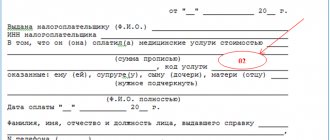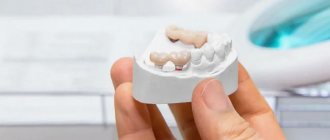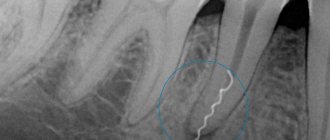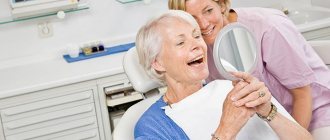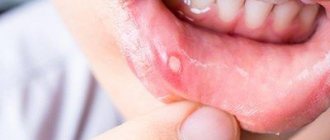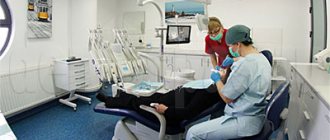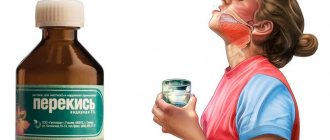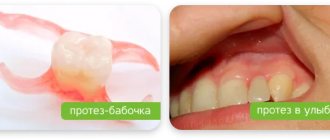Not every patient knows that part of the money spent on dental treatment in our clinic can be returned to the tax office. Based on Art. 219 clause 1 clause 3 of the Tax Code of the Russian Federation, each taxpayer has the right to an annual social tax deduction for treatment, but not more than 120,000 rubles in the tax period.
Tax deduction restrictions do not apply to expensive types of treatment; compensation is made in the amount of actual expenses incurred.
The list of expensive types of treatment was approved by a decree of the Government of the Russian Federation. Implantation of dentures is included in the list of expensive medical services. Social tax deduction provided for in paragraphs. 3 p. 1 art. 219 of the Tax Code of the Russian Federation, allows taxpayers (patients) to reduce the tax base for personal income tax by the amounts they paid in the tax period for treatment services:
- in medical institutions of the Russian Federation;
- spouse;
- parents;
- children under 18 years of age.
What kind of treatment can I get a tax deduction for?
You can receive a tax deduction for any dental services if they were provided in a licensed clinic (Article 219 of the Tax Code). However, there are exceptions, for example, teeth whitening is not included in the list of services for which you can receive a deduction.
Compensation for dental prosthetics
Prosthetics are also included in the list of services for which you can receive a tax deduction. And considering that this is one of the most expensive manipulations, you can get the most attractive payments for prosthetics.
Who can receive a deduction?
Any person who had income in the year of providing dental services on which 13% personal income tax was paid can receive a tax deduction.
Failure Cases
The Federal Tax Service has the right to refuse a tax deduction in the following cases:
- insufficient package of documents, there is no confirmation of the right to receive benefits;
- payment was made by a person who is not a relative of the taxpayer;
- a tax refund for the taxable year was received earlier;
- submitting documents for a child over 18 years of age;
- critical errors when filling out the declaration;
- The dentist's license has been revoked;
- therapy was carried out outside the country;
- the employer did not provide a tax report;
- a package of documents was sent to the Federal Tax Service not at the place of registration.
In case of refusal, the inspection sends information to the applicant and explains the reason. It is necessary to make the appropriate changes and provide the missing documents, then apply for a tax refund again. If the taxpayer does not agree with the refusal, he can challenge the decision of the Federal Tax Service within a year. Repeated denial of social opportunity becomes the reason for filing an application to court.
You can get a tax deduction even if you are not officially employed
You can receive a tax deduction for dental services not only for your own treatment, but also for services provided to parents, children, and spouse. Thus, even non-working pensioners, schoolchildren, students, people without official income can receive a tax deduction with the help of their relatives with a stable job. How to receive compensation for dental prosthetics for a pensioner? Through relatives who work with official registration. As a rule, one of the parents receives a tax deduction for dental treatment of a child.
What medical services are covered?
A social deduction for personal income tax for treatment can be obtained by:
- paid medical services. This may include paid tests, ultrasound and other types of diagnostics, medical procedures, dental treatment, etc.
For deduction, services can be provided to the individual himself, his spouse, parents, as well as children (including adopted children) and wards under the age of 18;
- paid for expensive treatment.
- paid prescription drugs, including for family members.
The amount of social deduction for treatment is provided in the amount of actual costs, but is limited to a total amount of 120,000 rubles for the tax period. In money it is 15,600 rubles. This limit does not include expensive treatment.
Tax refund for dental treatment: instructions
Documentation
Documents for tax deductions for dental treatment must be prepared in advance and submitted all at once. To receive a tax deduction for dental treatment, you need to provide:
- Passport.
- Certificate 2-NDFL and tax return 3-NDFL.
- Application for a deduction.
- Receipt(s) for payment for dental services.
- Agreement with the clinic that provided the services.
- ·Copy of the clinic license.
If you receive a tax deduction for your relative, you need to collect additional documents:
- Child's birth certificate (if the child was treated).
- Birth certificate of the person who will receive the deduction (if the parent was treated).
- Marriage certificate (if services were provided to the husband or wife).
Statement
The application is completed using a special form. It is better to request it from the Federal Tax Service so that you definitely have the correct document. You can look at examples and templates on the Internet, but we do not recommend downloading templates from unfamiliar sites; in this case, it is better to play it safe and once again check that you have the latest and most up-to-date form.
By the way, the tax office can help you fill out an application if you doubt that you can take into account all the nuances yourself.
The procedure for filing a deduction for dental prosthetics
There are two ways to reimburse funds: the Federal Tax Service at the place of registration or by the employer. The first option involves transferring funds to your personal account one-time in full. The second is receiving a salary without deducting personal income tax within the deduction amount.
Registration procedure
- It is necessary to keep the contract and receipts for payment, including diagnostics, therapy, and production of prostheses.
- After a year, contact a medical institution and request a certificate of a certain form.
- Fill out a declaration of income, where you indicate the right to a refund.
- Send the declaration and package of documents to the Federal Tax Service at the place of registration;
- Wait for the results of the desk audit within three months.
- To receive funds, write an application indicating account details for the tax service or provide a document to the employer.
You can file an income declaration yourself on the inspection website www.nalog.ru, as well as in the taxpayer’s individual account. There you can track the progress of the desk audit and decisions on payments.
Saving percentage
Today, the maximum amount of compensation for installed braces is 120 thousand rubles. Of this amount, the obedient taxpayer gets the opportunity to return only 13%.
It is clear that a 13% reimbursement is an insignificant help during expensive orthodontic treatment, however, these funds will not be superfluous in the process of long-term correction.
It is important to know! The size of the payment depends on the amount of income tax (NDFL) paid by an individual within 12 months.
To accurately determine the amount of payment, experts recommend using the following formula:
SV = ZS * 13%, where SV is a social deduction, ZS is the amount spent (costs of medical services, purchase of a structure).
Let's find out together how to properly brush your teeth with braces, and whether additional devices are needed.
Come here if you are interested in reviews about whether it hurts to get braces.
At this address https://orto-info.ru/sistemyi-vyiravnivaniya-zubov/breketyi/skolko-stoyat-tsena.html we will calculate how much braces for children cost.
Important nuances of implementing deductions
To save time and effort on the annual collection of documents, it is better to submit all the papers at once for each year in which dental procedures were completed.
If the patient completes treatment and prepares the necessary documentation within the period of 3 years allotted by law, he will receive compensation. If braces were installed in 2022, you have until 2021.
If you undergo procedures at a clinic where the costs for braces components are paid separately, you will not be able to receive reimbursement for these costs. They will be deducted from the total amount of compensation.
Deduction for unemployed citizens
The most important condition for the implementation of the deduction is the payment of income tax. It is levied not only on wages, but also on other sources of income. These are:
- Funds from the rental of real estate.
- Income from the sale of movable or immovable property.
- Provision of civil law services.
If a non-working parent who has paid the 13% personal income tax required by law applies for reimbursement for a child’s braces, he can submit an application for a refund to the Federal Tax Service.
Are all costs included in this amount?
No, not all. A tax deduction is provided for diagnostic and therapeutic procedures and consumables, but its amount does not include the cost of orthodontic structures. Therefore, the clinic usually breaks the cost of treatment into separate components.
For example:
- Therapeutic dental treatment.
- Implant installation. The deductible amount includes: the initial doctor’s appointment and the taking of a diagnostic image, treatment planning and the operation to install it, repeat appointments, crown installation.
- Correction of bite with braces: diagnosis, installation of the system, techniques during treatment and activation, replacement of the arch, removal - are included in the deductible amount, but the cost of the system itself and its components is not.
- When treating with aligners, a deduction is also applied to the amount of the doctor’s work.
Is installing braces considered an expensive treatment?
This dental procedure does not fall into the category of expensive treatment. In a letter from the Federal Tax Service of Moscow dated August 19, 2010 No. 20-14/4/ [email protected] this issue was raised. The letter states that a refund for orthodontic treatment, including the use of braces, can be claimed taking into account a number of restrictions set out in the Tax Code of the Russian Federation (Article 219, paragraph 2).
The state will reimburse the taxpayer for the following expenses for medical services:
- Manufacturing and installation, removal of braces.
- Visiting the dentist.
- Cleaning the mouth, etc.
Important! The personal income tax refund amount will not include the costs of consumables for the braces system: springs, elastic bands, arches, since the procedure is not included in the list of expensive treatments.
Insurance policy
A deduction can also be obtained in cases where no medical procedures were performed, no medications were purchased, and the money was spent on paying for a voluntary health insurance policy. In this case, the deductible applicant will need a certified copy of the insurance policy or agreement with the insurance company.
A deduction will be possible only if the insurance contract provides for payment for treatment services, and the insurance organization has a license to carry out this type of activity.
A certified copy of the license is submitted to the inspection. Or a link to its details should be given in the contract.
The above documents must be accompanied by certified copies of payment documents indicating that the funds were spent on paying insurance premiums.
Bottom line
Installing a braces system is not a cheap pleasure, so applying for and receiving a tax deduction based on the medical services received is an excellent opportunity to get back some of the money spent. If an adult is undergoing treatment, he applies to the Federal Tax Service or the employer with the appropriate package of documents independently. When it comes to correcting a child’s bite, all procedures related to compensation for payments are carried out by the parents (one or both at the same time). 13% of the cost of consumables will not be refunded; only medical services will be counted.
What conditions must be met?
To receive compensation payments, it is important to pay attention to the following conditions:
- The clinic that the patient has chosen to undergo orthodontic therapy must have an appropriate license to conduct medical activities and be registered in the Russian Federation (payments are not made for treatment in foreign institutions).
- A citizen who is planning to apply for a tax deduction must be officially employed or have any other income that is taxed at a personal income tax rate of 13% during the period when orthodontic treatment was carried out.
- No more than 3 years should pass from the moment the entire amount for braces was paid.
Recipe (form 107/1-у)
This small piece of paper will be required by the deductible applicant if the money was spent on medications that were prescribed by a doctor. The prescription is issued by the attending physician simultaneously with a similar form for the pharmacy. If form 107/1-у is missing, it can be obtained later from a medical institution based on the entries in the medical record.
The prescription must be stamped: “For the tax authorities of the Russian Federation, Taxpayer INN.” The stamp is also required after the cancellation of the medicinal list (see letter of the Ministry of Health dated December 30, 2019 No. 25-1/3144694-13771).
You can claim a deduction for the amount of paid medications for periods starting from 2019 for any medications prescribed by a doctor. But deductions for past periods can only be obtained if the purchased medications are included in the list approved by Resolution No. 201.
Tax officials must provide the original prescription and certified copies of payment documents. In this case, their presence is mandatory.
